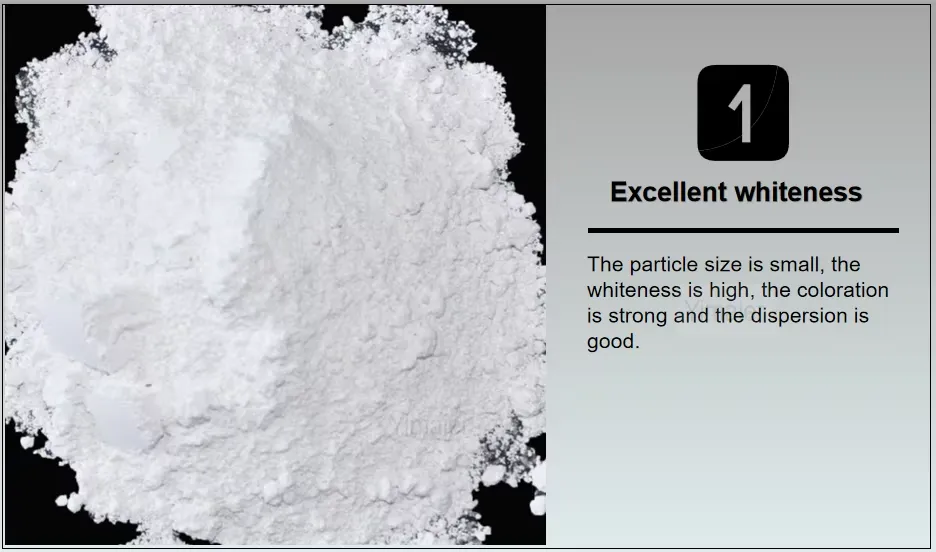
Th12 . 05, 2024 06:21 Back to list
Wholesale High-Quality Tinting Strength with Titanium Dioxide for Superior Performance
Understanding Wholesale Excellent Tinting Strength of TiO2
Titanium dioxide, commonly referred to as TiO2, has become one of the most widely utilized white pigments in various industries due to its excellent properties, including high refractive index, brightness, and opacity. One of the key aspects that differentiate various grades of TiO2 is its tinting strength, which plays a crucial role in applications ranging from paints and coatings to plastics and cosmetics.
The Importance of Tinting Strength in TiO2
Tinting strength refers to the ability of a pigment to impart color when mixed with a base. In the context of TiO2, this characteristic is essential for achieving the desired whiteness and opacity in products. A high tinting strength means that a smaller amount of pigment can be used to achieve the same level of opacity and brightness, which can lead to cost savings, improved formulation efficiencies, and enhanced product performance.
Factors Influencing Tinting Strength
Several factors influence the tinting strength of TiO2. Primarily, the particle size and distribution of TiO2 play significant roles. Smaller particles tend to have a higher surface area, which can enhance the interaction between the pigment and the medium, leading to improved tinting efficiency. Additionally, the crystalline form of TiO2 affects its refractive index and, consequently, its tinting strength. Rutile titanium dioxide is known for its superior tinting strength compared to its anatase counterpart.
Another critical factor is the surface treatment of the TiO2 particles. Many manufacturers employ different coatings or treatments to improve dispersibility, stability, and tinting strength. These treatments can enhance the pigment's performance in specific applications, allowing for better color development and lasting power in finished products.
wholesale excellent tinting streng tio2

Applications of Excellent Tinting Strength TiO2
The high tinting strength of TiO2 makes it an ideal choice for a range of applications. In the paint and coatings industry, it is used to produce high-quality paints that provide excellent coverage and durability. The ability to achieve a rich, vibrant color with less pigment is particularly advantageous for manufacturers looking to optimize their formulations while reducing costs.
In the plastics industry, TiO2 serves not only as a pigment but also as a UV stabilizer, protecting materials from degradation due to sunlight exposure. Its high tinting strength ensures that finished products maintain their brightness and do not appear dull or faded over time.
Moreover, TiO2 is used in cosmetics and personal care products, where its opacity and whiteness contribute to the overall aesthetic and performance. The ability to create formulations that are both safe and visually appealing is crucial in this sector, and TiO2’s excellent tinting strength plays an essential role in achieving these goals.
Conclusion
In conclusion, the wholesale excellent tinting strength of TiO2 is a significant factor that drives its popularity across various industries. As manufacturers continue to seek ways to improve product performance while reducing costs, TiO2 remains a critical component in the formulation of paints, coatings, plastics, and cosmetics. Understanding the factors that impact tinting strength can help businesses select the right grade of TiO2 for their specific applications, ensuring optimal results and customer satisfaction.
As the demand for high-quality products increases, the role of TiO2 with its exceptional tinting strength will continue to be pivotal. Innovations in production techniques and surface treatment technologies may further enhance the performance of TiO2, reinforcing its status as an indispensable pigment in the marketplace. Whether it's for achieving vibrant hues in paints or maintaining the visual appeal of consumer goods, titanium dioxide stands out as an essential material for countless applications.
-
China Lithopone in China Supplier – High Quality Lithopone ZnS 30% Powder for Wholesale
NewsJun.10,2025
-
Top China Titanium Dioxide Company – Premium TiO2 Powder Supplier & Manufacturer
NewsJun.10,2025
-
Fast Shipping 99% Pure TiO2 Powder CAS 13463-67-7 Bulk Wholesale
NewsJun.10,2025
-
Top China Titanium Dioxide Manufacturers High-Purity R996 & Anatase
NewsJun.10,2025
-
Lithopone MSDS Factories - Production & Quotes
NewsJun.10,2025
-
High-Quality Titanium Dioxide in Water Suppliers - China Expertise 60
NewsJun.09,2025
